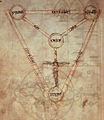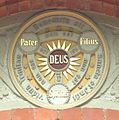Schild der Dreifaltigkeit
Der Schild der Dreifaltigkeit (lat. scutum Trinitatis), älter Schild des Glaubens (scutum fidei, nach Eph 6,16 ), ist eine im Hochmittelalter entwickelte grafische Veranschaulichung der christlichen Dreifaltigkeitslehre. Er wurde vor allem in der frühen Neuzeit als religionspädagogisches Hilfsmittel, als Kirchenschmuck und als heraldisches Zeichen verwendet.
- Älteste bekannte Darstellung bei Petrus von Poitiers, um 1210
- Das Scutum als „Gotteswappen“ im Wernigeroder Wappenbuch, um 1480
- Jerónimo Cosida (1510–1592), Dreifaltigkeit
- Relief über dem Portal der St.-Josefs-Kirche in Einbeck, 1895
- Schematische Darstellung
Gestalt und Bedeutung
Das Sinnbild veranschaulicht die paradoxe Glaubenslehre, dass der eine Gott in drei Personen existiere, die unterschieden, aufeinander bezogen und so dennoch eins seien. Als direkte theologische Grundlage gelten die Trinitätsaussagen des Athanasischen Glaubensbekenntnisses.
Dementsprechend ist die Grundgestalt ein Dreieck aus Schriftbändern, an dessen Ecken sich Kreise befinden. Von diesen führen drei weitere Schriftbänder zu einem – meist grafisch hervorgehobenen – Kreis in der Mitte. Die Eckkreise tragen die Beschriftungen Pater („Vater“), Filius („Sohn“) und [Sanctus] Spiritus („[Heiliger] Geist“), der Mittelkreis die Inschrift Deus („Gott“). Auf den äußeren Schriftbändern steht jeweils non est („ist nicht“), auf den zur Mitte führenden est („ist“). Die Schriftbänder können so gelesen werden, dass jeder der Kreise das grammatische Subjekt oder das Prädikativum enthält, also in beiden Richtungen. So ergeben sich die Sätze:
- Pater est Deus. – Deus est Pater.
- Der Vater ist Gott. – Gott ist der Vater.
- Filius est Deus. – Deus est Filius.
- Der Sohn ist Gott. – Gott ist der Sohn.
- Spiritus est Deus. – Deus est Spiritus.
- Der Geist ist Gott. – Gott ist der Geist.
- Pater non est Filius. – Filius non est Pater.
- Der Vater ist nicht der Sohn. – Der Sohn ist nicht der Vater.
- Pater non est Spiritus. – Spiritus non est Pater.
- Der Vater ist nicht der Geist. – Der Geist ist nicht der Vater.
- Filius non est Spiritus. – Spiritus non est Filius.
- Der Sohn ist nicht der Geist. – Der Geist ist nicht der Sohn.
Die Schildform symbolisiert zugleich die Abwehr der Irrlehren und die Königsherrschaft des Dreifaltigen Gottes.
Literatur
- Frederick Roth Webber: The Shield of the Trinity. In: Ders.: Church Symbolism. An explanation of the more important symbols…. Cleveland 1927, S. 44–46
Weblinks
Auf dieser Seite verwendete Medien
Detail from Cotton Faustina manuscript B. VII, folio 42v, showing a "Scutum Fidei" or Shield of the Trinity triangular diagram, with a representation of Christ on the cross.
This is part of a ca. 1210 illustration to the Compendium Historiae in Genealogia Christi by Peter of Poitiers (or Petrus Pictaviensis).
The Latin text on the shield in the image includes the words or scribal abbreviations for "PATER" (the Father), "SPIRITUS SANCTUS" (the Holy Spirit), and "FILIUS" (the Son) in the three outer nodes, and "DEUS" (God) in the center node. The text in the links connecting the outer nodes to each other reads "NON EST" (Is not), while the text along the links connecting the center node to the outer nodes reads "EST" (Is).
For the history and meaning of this general "Shield of the Trinity" or "Scutum Fidei" diagram of traditional western Christian symbolism (a visual summary of the first part of the Athanasian Creed), see the main article en:Shield of the Trinity. The reason for placing "Filius" in the bottom node of this version of the diagram, with a illuminated representation of the Crucifixion above it, is presumably the same as for a ca. 1250 version of the diagram included in Matthew Paris' Chronica Majora, where the diagram was annotated with the Latin Vulgate version of the Biblical passage meaning "The Word was made flesh" (from the Gospel of John, verse 1:14).
This is the chronologically earliest known version of the Scutum Fidei or
Shield of the Trinity diagram.„Wernigeroder (Schaffhausensches) Wappenbuch“; Süddeutschland, 4. Viertel 15. Jh.
Bayerische Staatsbibliothek München, Cod.icon. 308 n
Fiktives Wappen Gottes (Wappenschild der Dreieinigkeit)
Small and compact version of a basic minimal (equilateral triangular) version of the "Shield of the Trinity" or "Scutum Fidei" diagram of traditional Christian symbolism, with original Latin captions.
For a larger version of this, see Image:Shield-Trinity-Scutum-Fidei-basic.png .
For other versions of this emblem, see Image:3enighed.png , Image:Shield-Trinity-medievalesque.png , Image:Trinidad-Anglican-Episcopal-Coat-of-Arms-large.png , and Image:Trinity knight shield.jpg . For discussion and explanation, see the main article en:Shield of the Trinity .Autor/Urheber: Rabanus Flavus, Lizenz: CC0
Relief über dem Portal der St.-Josefs-Kirche in Einbeck, 1895









